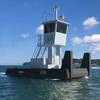Representing an important milestone for U.S. commercial shipbuilding, the delivery of the 141,740-dwt Polar Endeavour signaled the unfolding of a major new chapter of investment in the fleet dedicated to coastwise transportation of Alaskan crude oil. Giving first form to the Millennium concept, the tanker has been purpose-designed for trade in the world's most environmentally-sensitive waters. While Polar Tankers' main requirement of the Millennium-class is to ship crude to Puget Sound from the Trans Alaska Pipeline terminal at Valdez, the series is also suited to the needs of the traffic to California and Hawaii. The program had been implemented in 1997, when former Avondale Industries was awarded the first vessel by California-based Arco Marine, the predecessor of Phillips Petroleum's Polar Tankers. Five vessels of the Polar Endeavour-type have been ordered to date from Litton Avondale for Polar Tankers, and options are outstanding on sixth and seventh tankers.
While ranking as the first, pure crude carrier of double-shell construction to have been ordered in the USA, she has the added distinction of a twin-engine, twin-screw configuration and a double-hull spacing of 10ft, 50-percent greater than the mandatory minimum. The landmark class, combining proven technologies and innovative features, is a response to rising expectations as to service dependability and environmental compatibility.
Two low-speed MAN B&W diesel engines, the discrete arrangement of machinery and fuel systems, and independent rudders and steering gear, confer an exceptional degree of redundancy in a crude oil tanker context. Polar Endeavour's total loading capacity of just over 1-million barrels of oil is encased in 12 cargo tanks, arranged in six pairs about the centerline longitudinal bulkhead. Polar takes the view that the double-shell should be treated as the last line of defense. Citing failure of major systems such as the engine or rudder as a significant cause of marine accidents, it has therefore championed the concept of redundancy throughout the new tanker. Each seven-cylinder MAN B&W S50MC-C prime mover has a nominal output of 15,015-bhp(11,060-kW), and the total propulsive effect ensured a speed of 16.55-knots at laden draft marks. The engines are installed in two completely independent machinery rooms, separated by a longitudinal, watertight bulkhead. Each main engine drives a Kamewa controllable pitch propeller through a Renk PTO (power take-off) tunnel gear, for electrical power generation, and through a Renk friction clutch and thrust bearing, to allow disengagement of the propeller shaft. A multi-plate clutch in the gear interfaces with an ABB shaft generator of 8,600-kW. The rationale for the system is to enhance overall operating economics by harnessing main engine rotational energy to cover the electrical load while under way, and to also step-up PTO generator power, with the propeller disengaged, to meet the heightened electrical power need for cargo working. The arrangements enable the plant to be operated in three principal modes, covering open-sea navigation, maneuvering and cargo handling.
The strength and durability of the vessel structure has been bolstered in the light of over 20 years' operational experience of tanker structural performance in the harsh Alaskan environment. The ship has been built primarily with mild steel, employing above-regulatory margins in areas where high tensile steel has been used, as in the upper deck, sheer and deck strakes and high-stress structural details.
The owner claims that the design incorporates 8,000-tons more steel than a comparable-capacity tanker intended for a typical international trade route. Steel placement to best effect has been guided by state-of-the-art, computer-aided structural design techniques, with the goal of ensuring the requisite 30-year fatigue life. Polar's antecedent Arco Marine considered the latest generation of North Sea shuttle tankers, which have to maintain similarly demanding service patterns in arduous environments, when laying down a basis for the design. Accordingly, input on shuttle tanker design and construction from IZAR contributed to the U.S. company's investigations, as did assistance from Norwegian offshore tanker operator Knutsen OAS Shipping. The broad-based technical input to the project has also involved consultancies J J McMullen, MCA Engineers, Herbert Engineering, Glosten Associates and SSPA Sweden.
Featured videos

Inmarsat Enhances Service to Drive Digitalization

Inside the Electrified Truckable Tug

Tracking Foreign Vessels Working in the U.S. Jones Act Market
Subscribe for
Maritime Reporter E-News
Maritime Reporter E-News is the maritime industry's largest circulation and most authoritative ENews Service, delivered to your Email five times per week









